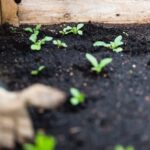
Permaculture gardening is a sustainable and regenerative approach to cultivating land that aims to create harmonious ecosystems. It goes beyond traditional organic gardening by integrating principles of ecological design, renewable energy, and resource conservation. In permaculture gardens, the focus is on working with nature rather than against it, emphasizing the importance of biodiversity, minimal waste, and self-sufficiency.
The concept of permaculture gardening was first developed in the 1970s by Australian ecologists Bill Mollison and David Holmgren. They envisioned a way of designing agricultural systems that mimicked natural ecosystems, using principles such as observing patterns and interactions, recognizing that everything is interconnected, and maximizing the use of resources on-site.
One of the main benefits of permaculture gardening is its potential for creating resilient and productive landscapes. By incorporating diverse plant species that serve multiple functions, such as providing food, shade, or attracting beneficial insects, permaculture gardens can maximize their yields while minimizing input requirements. Additionally, these gardens require less water and energy compared to conventional practices, making them more environmentally friendly.
In this article, we will delve into the key principles of permaculture gardening and explore how they can be applied in designing and managing your own garden space. We will also provide practical tips on choosing suitable plants for your permaculture garden, setting up a compost system for nutrient-rich soil, implementing efficient water management techniques, promoting biodiversity through integrated pest management strategies, caring for your garden throughout the seasons, and making the most out of your harvests.
Join us as we embark on an exciting journey towards self-sufficiency and sustainability through permaculture gardening.
The Principles of Permaculture Gardening
Permaculture gardening is a sustainable and holistic approach to gardening that aims to mimic the patterns and relationships found in natural ecosystems. It is based on a set of principles that guide gardeners in creating gardens that are not only productive but also environmentally friendly. The key principles of permaculture gardening include minimal waste, diversity, and self-sufficiency.
Minimal waste is an important principle in permaculture gardening. It emphasizes the use of resources efficiently and reducing waste as much as possible. In a permaculture garden, organic matter such as kitchen scraps, leaves, grass clippings, and prunings are reused through composting or mulching. This not only reduces waste but also helps improve soil fertility and moisture retention.
Diversity is another essential principle in permaculture gardening. By incorporating a wide variety of plants, animals, and beneficial organisms into the garden ecosystem, it becomes more resilient to pests and diseases. Diversity also enhances pollination and nutrient cycling, leading to healthier plants and higher yields. In a permaculture garden, various types of crops are grown together in polycultures rather than monocultures to enhance biodiversity.
Self-sufficiency is a core principle of permaculture gardening where the aim is to create systems that meet the needs of the garden with minimal external inputs. This can be achieved through practices such as planting perennial food crops that require less maintenance and providing long-term yield potential.
Other strategies for self-sufficiency include implementing rainwater harvesting systems for irrigation, preserving excess harvests for future use, saving seeds for propagation, and using natural pest control methods instead of relying on chemical pesticides.
| Key Principles | Description |
|---|---|
| Minimal Waste | Efficient use of resources, composting organic matter |
| Diversity | Incorporating a wide variety of plants and animals for resilience |
| Self-sufficiency | Creating systems that meet the garden’s needs with minimal external inputs |
By following these principles, permaculture gardeners can create thriving, sustainable, and productive gardens that work in harmony with nature.
Designing a Permaculture Garden
To create a successful permaculture garden, careful planning and design are essential. The process begins with a thorough site assessment to understand the existing conditions and potential of the land. This assessment involves observing factors such as sunlight exposure, soil quality, water sources, and existing vegetation.
Site Assessment
The first step in designing a permaculture garden is to assess the site. Understanding the natural resources available on your land helps determine what can be grown sustainably. Observe how sunlight moves across the area at different times of day to identify areas with full sun, partial shade, or deep shade. Assess the soil quality by looking for its texture, fertility, and drainage capability. Additionally, consider any prevailing wind patterns or microclimates that may affect plant growth.
Zoning
Zoning is an important concept in permaculture design that involves dividing your garden into different zones based on frequency of use and plant requirements. Zone 1 is closest to your home and usually consists of small-scale intensive gardens where you grow high-maintenance crops like vegetables and herbs that require frequent attention.
As you move further away from your home (Zone 2), you can grow larger fruit trees and bushes that require less maintenance but still need regular monitoring. Zones 3 to 5 generally consist of more extensive food forests where perennial crops are established with minimal intervention.
Sector Analysis
A sector analysis helps identify external influences such as wind direction, noise pollution, views, or potential sources of pests that can impact your garden’s success. By understanding these elements through careful observation and analysis, you can plan accordingly to minimize their negative effects or even utilize them to benefit your garden ecosystem.
For example, if you have a strong prevailing wind, you can strategically plant windbreaks or use it to your advantage by harnessing the energy for powering devices like wind turbines.
Designing a permaculture garden is an exciting and creative process that allows you to work in harmony with the natural environment. By conducting a thorough site assessment, zoning your garden appropriately, and analyzing external factors through sector analysis, you can create a well-planned and resilient garden that thrives for years to come.
Choosing the Right Plants
Choosing the right plants is a crucial aspect of permaculture gardening, as they play a vital role in creating a healthy and productive ecosystem. When selecting and incorporating plants into your permaculture garden, it is important to consider their functions and the benefits they offer. Here is a comprehensive guide to help you make informed decisions about which plants to choose for your permaculture garden:
- Food Plants: One of the main goals of permaculture gardening is to produce food sustainably. Incorporating edible plants such as fruits, vegetables, herbs, and nuts can provide you with a constant supply of fresh produce. Consider selecting perennial food plants like apple trees, berry bushes, or perennial vegetables that require less maintenance and provide long-term yields.
- Nitrogen Fixing Plants: Plants that have the ability to fix nitrogen from the atmosphere can improve soil fertility by replenishing this essential nutrient naturally. Legumes such as beans, peas, and clover are excellent choices for nitrogen fixation. They form a symbiotic relationship with bacteria in their roots called nodules that convert atmospheric nitrogen into a usable form.
- Dynamic Accumulators: Some plants have deep taproots that draw up nutrients from deeper soil layers and accumulate them in their leaves or stems. These nutrient-rich plant parts can be used as chop-and-drop mulch or turned into compost to enrich the topsoil. Examples of dynamic accumulators include comfrey, yarrow, nettle, and dandelion.
- Beneficial Insect Attractors: Encouraging beneficial insects in your permaculture garden helps control pests naturally without relying on harmful chemicals. Selecting plants that attract pollinators such as bees and butterflies, as well as predatory insects like ladybugs and lacewings, can enhance biodiversity and promote ecological balance. Flowers like marigold, lavender, sunflowers, and fennel are known for their insect-attracting qualities.
- Ground Covers: Ground cover plants protect the soil from erosion, suppress weeds, and conserve moisture. They can also provide habitat for beneficial insects and contribute organic matter to the soil when cut back or mulched. Examples of suitable ground covers include creeping thyme, clover, sweet potatoes, and low-growing herbs like oregano or chamomile.
By carefully selecting and incorporating a diverse range of plants in your permaculture garden, you can create a thriving ecosystem that is both productive and sustainable. Remember to consider the functions and benefits of each plant, as well as their compatibility with the garden’s overall design and objectives.
Creating a Compost System
Composting is a fundamental aspect of permaculture gardening as it helps to close the loop on waste management while nourishing the soil with nutrient-rich organic matter. By creating a compost system, you can effectively recycle kitchen scraps, yard trimmings, and other organic materials, reducing your reliance on external inputs such as chemical fertilizers. This section will highlight the importance of composting in permaculture gardening and provide tips for setting up a successful compost system.
To start a compost system, it is important to choose an appropriate location. Ideally, the compost pile or bin should be placed in a convenient spot that receives partial sunlight. It’s also beneficial to pick an area with good airflow to aid in the decomposition process. Once you have chosen the location, you can begin assembling your compost pile.
The first step is to gather your organic materials. A good mix of “green” and “brown” materials is essential for balanced composting. Green materials include nitrogen-rich items such as vegetable scraps, grass clippings, and fresh weeds. Brown materials consist of carbon-rich items like dried leaves, straw, and wood chips. Aim for a ratio of roughly three parts brown materials to one part green materials.
Next, layer your organic materials in the chosen container or directly on the ground if you prefer an open pile system. Remember to chop or shred larger items into smaller pieces to facilitate faster decomposition. As you add layers of material, try to moisten them slightly each time but avoid overwatering which can lead to anaerobic conditions.
Once your compost pile is fully assembled, it needs proper maintenance to achieve optimal decomposition. Regularly turning or mixing the pile helps introduce oxygen into the mix and speeds up decomposition by promoting aerobic microorganisms’ activity. Aim to turn your pile every two to three weeks or whenever the internal temperature drops significantly. Monitoring the moisture levels and adjusting as needed is essential for a healthy compost system.
By creating a compost system in your permaculture garden, you are not only minimizing waste but also producing nutrient-rich compost that enhances the fertility of your soil. Additionally, composting reduces greenhouse gas emissions that would otherwise be generated from waste in landfills. With proper planning and management, your permaculture garden can benefit greatly from a well-maintained compost system.
Water Management
One of the key principles of permaculture gardening is the efficient use and conservation of water. By implementing appropriate water management techniques, permaculture gardeners can maximize their water resources and minimize waste. This section will highlight some effective strategies for addressing water management in a permaculture garden, including rainwater harvesting, swales, and drip irrigation.
Rainwater harvesting is an essential practice in permaculture gardening as it allows gardeners to collect and store rainwater for later use. This reduces reliance on municipal water sources and conserves valuable resources.
There are various methods of rainwater harvesting, such as installing rain barrels or cisterns to capture water from rooftops, or creating rain gardens to capture and absorb runoff from the landscape. The collected rainwater can then be used for watering plants during dry periods, reducing the need for additional irrigation.
Swales are another effective technique for managing water in a permaculture garden. Swales are shallow channels or ditches designed to slow down and capture rainfall runoff. By strategically locating swales on contour lines across the landscape, gardeners can effectively catch and retain rainwater, preventing erosion and allowing it to infiltrate the soil. The water held in the swales can then gradually seep into the surrounding plant roots, providing essential hydration over a longer period of time.
Drip irrigation is a highly efficient method of delivering water directly to plant roots while minimizing evaporation and waste. This system uses hoses or tubing with emitters that release small amounts of water at a slow rate, ensuring that plants receive a consistent supply without excess runoff. Drip irrigation systems can be designed with timers or sensors to further optimize watering schedules based on specific plant needs and weather conditions.
Implementing these water management techniques not only helps conserve precious resources but also contributes to the overall resilience of a permaculture garden by promoting healthy plant growth and reducing the risk of water-related issues such as erosion and flooding. By thoughtfully addressing water needs, permaculture gardeners can create sustainable and productive ecosystems that thrive even in challenging environments.
Integrated Pest Management
One of the fundamental principles of permaculture gardening is promoting biodiversity, not only for the health of the ecosystem but also as a natural method to control pests and diseases. In a permaculture garden, pests are viewed as part of the larger ecosystem, and efforts are made to create a balanced environment where pest populations are kept in check by their natural predators. This approach eliminates or minimizes the need for chemical pesticides that can disrupt the ecological balance.
Companion planting is one effective technique used in permaculture gardening to manage pests naturally. Companion plants are those that have beneficial relationships with each other when grown together. They can either repel or attract specific pests, or provide diverse habitats for beneficial insects that prey on pests.
For example, marigolds repel aphids, nematodes, and certain beetles when planted alongside vegetables such as tomatoes and peppers. On the other hand, parsley attracts predatory insects like ladybugs and lacewings that feed on aphids.
In addition to companion planting, promoting biodiversity within a permaculture garden helps create a resilient ecosystem that can naturally deter pests. By growing a wide variety of plants and encouraging native species, you can attract beneficial insects that act as natural pest control agents. For example, planting flowers such as lavender and yarrow attracts bees and other pollinators which not only play an essential role in plant reproduction but also contribute to maintaining overall garden health by controlling pest populations.
| Pest Control Method | Benefits |
|---|---|
| Companion Planting | Repels or attracts specific pests; provides habitats for beneficial insects |
| Promoting Biodiversity | Attracts beneficial insects; creates a resilient ecosystem |
| Biological Controls | Uses natural predators or parasites to control pests |
Seasonal Care and Maintenance
Maintaining a permaculture garden requires ongoing care and attention throughout the year to ensure its health and productivity. Seasonal care and maintenance activities play a crucial role in optimizing the performance of the garden and promoting a sustainable ecosystem. This section will provide valuable tips and guidance for each season, focusing on pruning, mulching, and soil management.
In spring, one of the key tasks in maintaining a permaculture garden is pruning. Pruning helps shape plants, remove dead or damaged branches, promote airflow, and control their growth. It is essential to assess each plant’s specific needs before pruning to avoid excessive or unnecessary cutting.
Fruit trees should be pruned while dormant to improve fruit production, while herbaceous perennial plants can benefit from early spring pruning to encourage new growth. When pruning, it is important to use sharp tools to make clean cuts close to the branch collar or main stem.
Mulching is another critical aspect of seasonal care in a permaculture garden. Applying organic mulch around plants helps retain moisture in the soil, suppresses weeds, adds nutrients as it decomposes, moderates soil temperature fluctuations, prevents erosion, and improves soil structure. In summer months when evaporation rates are high, maintaining an adequate layer of mulch can significantly reduce water requirements for the garden. Organic materials such as straw, wood chips, leaves, grass clippings can all be used as effective mulch options.
Soil management is vital for the long-term health and fertility of a permaculture garden. Regularly testing the pH levels of the soil can help identify any necessary amendments needed to maintain optimal growing conditions for different plants. Depending on test results and plant requirements,.
compost,
well-rotted manure,
or specific mineral supplements may be added during appropriate times of the year. Additionally, practicing techniques such as cover cropping, crop rotation, and minimal soil disturbance help build organic matter, improve soil structure, prevent nutrient depletion, and reduce the risk of pest and disease buildup.
By following these seasonal tips and guidance for care and maintenance, permaculture gardeners can ensure that their garden thrives throughout the year. Remember to adapt these practices to suit your specific climate and local conditions. With proper care and attention, a well-maintained permaculture garden can provide a sustainable source of food, promote biodiversity, conserve resources, and contribute to a healthier environment.
Harvesting and Using the Yield
In conclusion, permaculture gardening offers a sustainable and holistic approach to growing food that benefits both the environment and individuals. By following the principles of minimal waste, diversity, and self-sufficiency, a permaculture garden can thrive and provide an abundant yield of produce. However, the true value of this abundance lies in how it is harvested and used.
One of the key aspects of harvesting from a permaculture garden is preserving the surplus for future use. This can be achieved through various methods such as canning, freezing, fermenting, or dehydrating. Preserving allows for enjoying homegrown produce throughout the year, ensuring that nothing goes to waste.
Sharing the yield with others is another important aspect of permaculture gardening. Whether it’s trading with neighbors or donating to local food banks and community organizations, sharing creates a sense of connection and strengthens community ties. It also helps spread the knowledge and benefits of permaculture gardening to a wider audience.
Lastly, utilizing the yield in nutritious meals is a gratifying way to enjoy the fruits of one’s labor. Cooking with homegrown ingredients not only provides delicious flavors but also ensures that meals are packed with fresh nutrients. From salads to stir-fries, soups to desserts, there are endless possibilities for creating wholesome dishes using produce straight from the garden.
In summary, harvesting and using the yield from a permaculture garden allows individuals to fully benefit from their efforts while minimizing waste and maximizing sustainability. Whether it involves preserving for later use, sharing with others, or preparing nutritious meals at home, utilizing the abundance nurtures both body and soul. Permaculture gardening truly offers a rewarding journey towards self-sufficiency and healthier living for individuals and communities alike.
Frequently Asked Questions
What is permaculture in gardening?
Permaculture in gardening is an ecological design approach that aims to create sustainable and self-sufficient systems that work harmoniously with nature. It is a holistic approach to gardening that considers the interactions and relationships between plants, animals, microorganisms, soil health, water conservation, and energy efficiency.
The principles of permaculture involve mimicking natural ecosystems by carefully observing and understanding how they function and applying those principles to create productive and resilient gardens.
What makes a permaculture garden?
A permaculture garden is characterized by its emphasis on diversity and interconnectedness. It utilizes various techniques such as companion planting, polycultures (growing multiple crops together), using native and perennial plants, organic fertilizers, natural pest control methods, rainwater harvesting, composting, and mulching.
These techniques aim to create a self-sustaining ecosystem where everything has a purpose and supports each other efficiently. The goal is to minimize waste, maximize yield, conserve resources like water and energy, promote biodiversity, and enhance the overall health of the garden.
How do I start a permaculture yard?
Starting a permaculture yard involves several steps. Firstly, assess your available space: consider factors such as sunlight exposure throughout the day, existing vegetation or structures that may need removal or integration into your design. Secondly, analyze the climate conditions of your area – rainfall patterns, temperature ranges – to better understand which plants will thrive in your yard.




